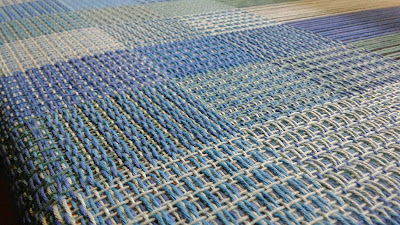I was asked about a month ago to weave a blanket for a baby shower. I was happy to do it but I didn't want to spend all the money in the world on materials, so 8/4 cotton fit the bill (literally). I picked out a set of four colors that looked great together, and that was my starting point. Then I had to decide on what to do with it.
All kinds of possibilities went through my head, and I looked everywhere I could think of for inspiration. This mostly consisted of image searches, a good romp around Pinterest, and browsing through back issues of Handwoven magazine. In the end, the two front-runners were turned taqueté and polychrome crackle weave, neither of which I'd ever woven before. Both had a nubbly sort of texture and were very conducive to baby-appropriate block patterns that would let me make all sorts of color combinations.
I think the reason crackle weave won out was two-fold: first, the blocks were all different to each other, which was not the case with the more uniform (and therefore comparatively boring) taqueté. The other reason had to do with the warp sett. My thinking was that crackle weave might be slightly more economical, because it seemed to use a looser sett. With fewer warp threads, not only would the warping process go a tiny bit faster, but also I'd have less loom waste. It might use up more yarn in the densely packed weft, but at least that yarn would actually end up in the finished blanket.
Warping
For crackle weave, use a loose tabby sett, and beat the weft to roughly twice as many picks per inch as ends per inch. I'm starting with this, because it's the key info that I had rather a hard time pinning down, though in the end I guessed right and it turned out for the best. So with 8/4 cotton, for example, the suggested tabby sett is 10-12 epi. I sleyed my reed on the looser end of this range at 10 epi, and I think it was just about perfect.
I based my project on Sarah H. Jackson's "In Celebration of Friendship" Towels in the September/October 2016 issue of Handwoven. It's a pattern for towels using 8/2 cotton, so I had to scale it up for a blanket in 8/4 cotton by adding an additional repeat within each pattern block. Since my yarn was twice as thick, I didn't have to make any further adjustments to the draft to make it work for a baby blanket. The original pattern used 8 colors, though, so I did have to adjust which colors went where.

For my first time at polychrome crackle weave, I thought everything went fantastically well. There were a lot of things that I've quickly come to really appreciate about this weave structure, or at least this particular draft. One of them was the incredible convenience of threading in color blocks. Not once did I lose my place and have to count threads, because all of the threads are pre-grouped and color-coded. How amazing! I usually start threading at one end and work my way across, but with this project I was able to start threading from the center.
Weaving
I had to restrain myself when it came to beating the weft, in order to keep it around 20 ppi. I am an inveterate rug weaver and I'm also fond of overshot, both of which require an enthusiastically vigorous beat. As a consequence, I always have to concentrate on holding back when I weave anything lighter -- and lighter, for me, does include thick blankets.
For the first time I got to use my Christmas present: a large Leclerc temple. I hadn't had the opportunity yet, because I hadn't woven anything wide enough. I got this 60" loom for blankets, though, so it's always a great feeling to take advantage of that generous width. It's only under exceptional circumstances now that I don't use a temple, because I find they make such a difference both while you're weaving and in the finished product.
Finishing
I love dumping the finished thing, whatever it is, in the wash and hoping for the best. It's like magic, how it transforms in there and seeing it when it comes out. Forgive the wildly varying colors in these two before-and-after pictures, which were taken under terrible lighting conditions:
Texture under tension & before washing
After hemming & washing
I observed just about exactly the shrinkage that I was expecting. Under tension on the loom, the blanket measured 46 x 58 (including hems). Off the loom and hemmed, it relaxed to 44.5 x 52. After wet finishing, it measures 38 x 46. A nicely generous blanket that the baby won't grow out of immediately.
Flash Forward
I enjoyed this project so much that I decided to tie on a new warp directly to the cut-off ends of the first. It wasn't my favorite thing in the world to tie 458 identical knots. It takes way longer than it sounds like it should. In fact it was a dreadful slog, and I'm not sure that I prefer it to starting from scratch. Nevertheless, the deed is done, and I'm looking forward to weaving four more blankets using different color combinations in the weft.









Comments
Post a Comment